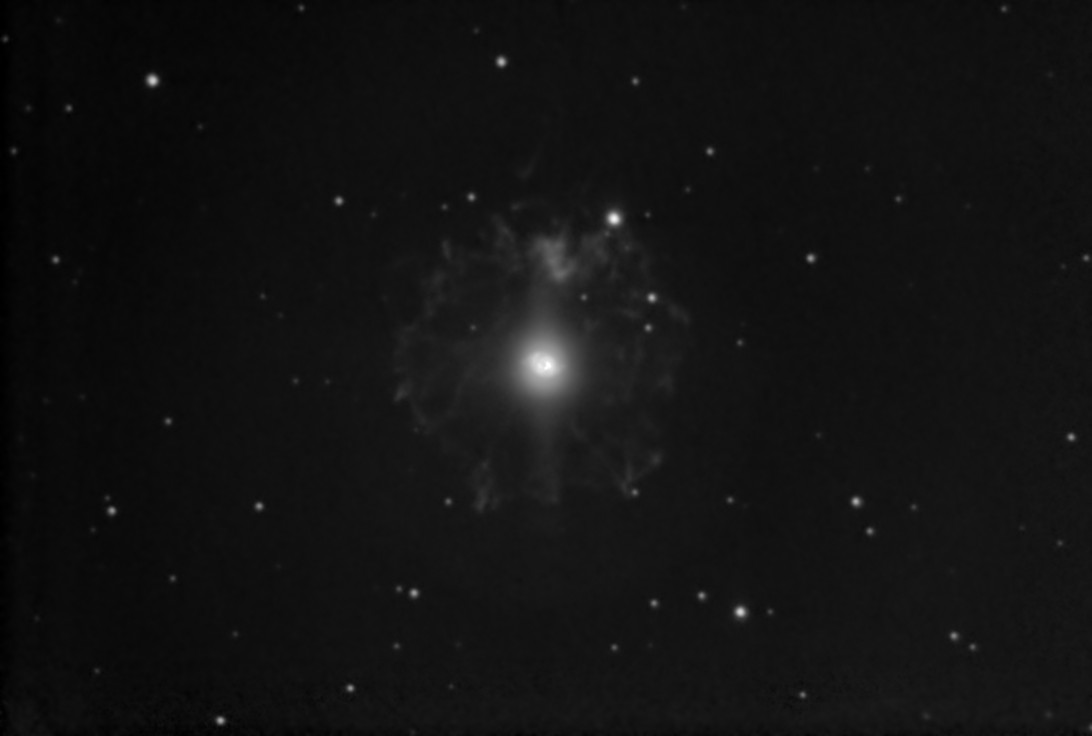NGC 6543
Cat's Eye in OIII

NGC 6543
Cat's Eye in OIII: The Cat's Eye nebula is approximately 3,500 light-years away, in the constellation Draco. It is one of the most complex nebulae known, leading to speculation that it might be the result of emissions from a binary central star. It falls nearly exactly in the direction of the North Ecliptic Pole, perpinducular to the plane of the solar system. The nebula is estimated to be approximately 1000 years old, based on measurements of its angular expansion. It was discovered by William Herchel in 1786 and was the first planetary nebula to be studied spectroscopically, by William Huggins in 1864. (http://en.wikipedia.org/wiki/NGC_6543)
NGC: 6543
Right Ascension: 17h 58.6m
Declination: 66° 38'
Apparent Magnitude: 9.8
Date: July 2009
Equipment: Telescope: Meade 16" Schmidt Cassegrain with f6.3 reducer
Camera: SBIG ST10-XE
Guiding: Meade 5" refractor/DSI Pro/PHD
6nm Astrodon [OIII] filter
Exposure: [OIII]: 37x5 minute and 24x1 minute
Processing Notes: Image reduction and alignment were done in CCDStack. Both 5 and 1 minute files were aligned together. Sigma Beta was used to combine the reduced images. Resulting FIT files were imported into Photoshop using FITs Liberator with an arcsine stretch. Images were further stretched using curves and levels, and the core from the 1 minute set was copied and pasted into the 5 minute set. Lots of smoothing on the dark areas. Minimal sharpening on the core.
Scale: 1.01
Additional Comments: A planetary nebula occurs when a sun-like star is reaching the end of its life. Typically, the star will have a core made of carbon, surrounded by a shell of helium (in the process of fusing into carbon), and outer layers of mostly Hydrogen. The fusing Helium will shrink and heat the core, attempting to fuse the carbon into heavier elements, but the temperature and pressure will never be great enough in a star of this (relatively low) mass to fuse the carbon. As a result, this very hot carbon core and helium shell drive off the outer layers of hydrogen. As these outer layers are driven off by the intense heat of the core, they form what is called a planetary nebula, that is visible as a shell of glowing gas surrounding a very hot central star. (Note that the term "planetary" has nothing to do with planets - they are called planetary because in early telescopes they appeared to be tiny fuzzy disks that reminded observers of planets!) Because the details of this shedding process can vary significantly from star to star, all planetary nebulae are unique, and many show multiple shells, as different layers are shed over a period of time. Eventually, the shell will dissipate and the hot core, now called a white dwarf, will remain. A white dwarf can have as much mass as the Sun, but compressed into a sphere the size of the Earth.
Views: 7563
 This work is licensed under a Creative Commons Attribution-NonCommercial-ShareAlike 4.0 International License.
This work is licensed under a Creative Commons Attribution-NonCommercial-ShareAlike 4.0 International License.

